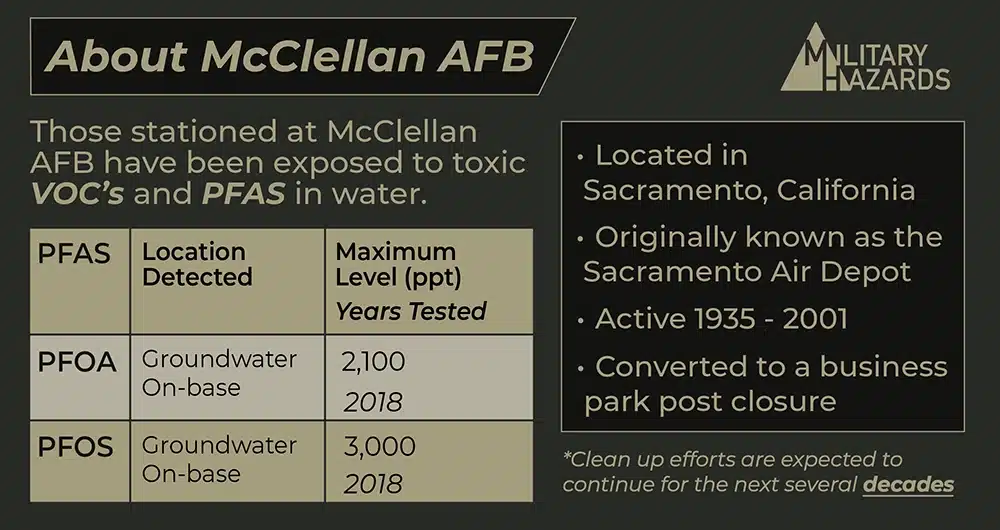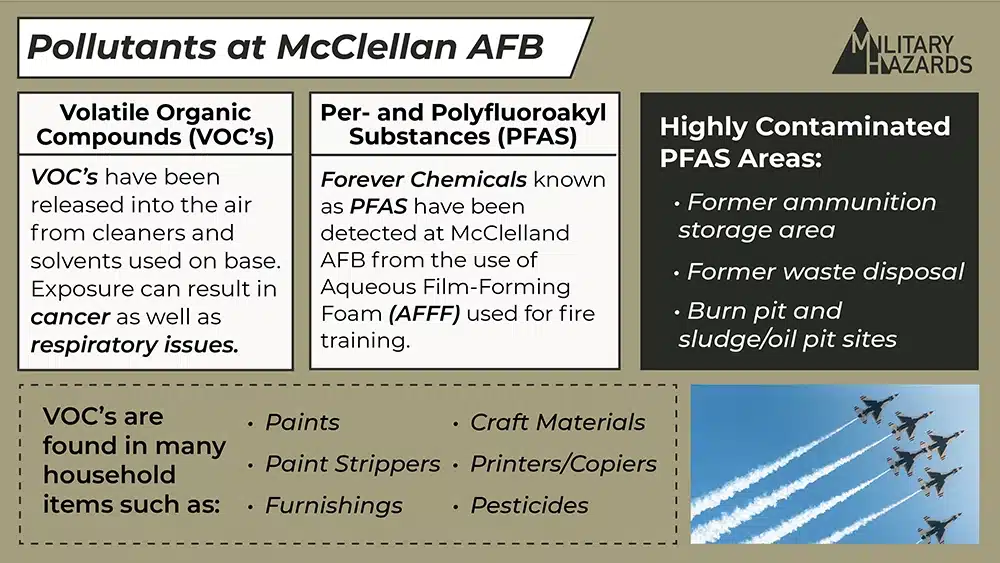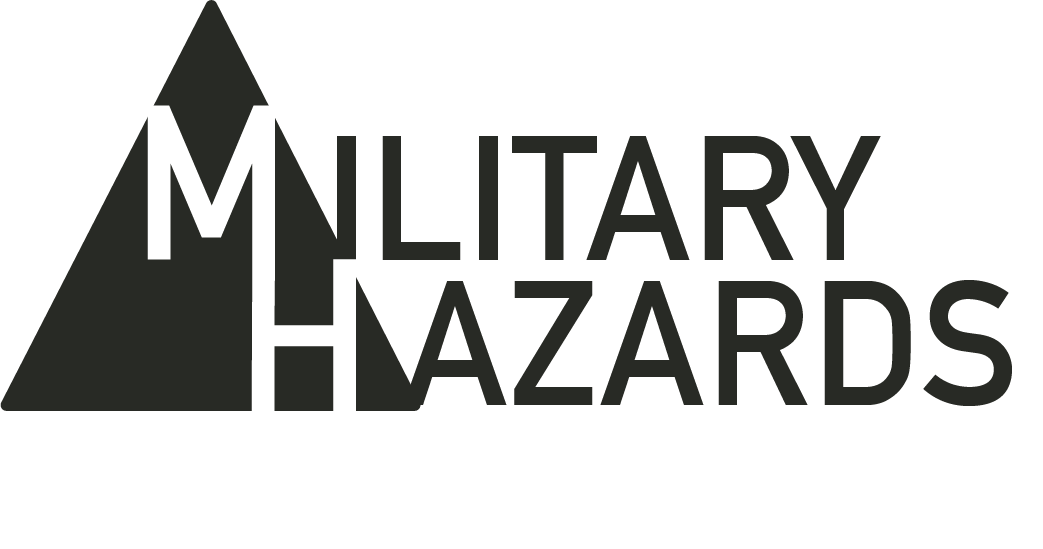Contact Our Legal Partner
"*" indicates required fields

McClellan Air Force Base Water Contamination
Originally commissioned as the Sacramento Air Depot in 1936, McClellan Air Force Base would serve communities of Northern California for over 60 years until its official closure in 2001. In 1939, the military installation’s name was changed to honor Maj. Hezekiah McClellan. While open the base supported air operations throughout the Western Coast of the United States. It also served as a staging area for aircraft and Pacific-bound material.
Since its closure, the base has been converted to a business park. The former base, however, has come under scrutiny because of environmental contaminants that have affected the groundwater and soil at and near the installation. Over $500 million has been poured into clean up efforts with another $400 million anticipated to be spent for the project.
Individuals, however, who were stationed at the base may have been exposed to toxic water. The contaminants at McClellan Air Force Base may cause significant health problems including an increased risk of cancer. If you or a loved one were stationed at McClellan Air Force Base and subsequently diagnosed with an illness related to toxic water exposure, you may be entitled to compensation. It is strongly recommended that you speak with an attorney.
At MilitaryHazards.org, we have extensive experience assisting active and former military service members who suffered harm after being exposed to toxic water at a military base. Contact us today to discuss your history at the base.

Water Contamination Updates at McClellan AFB
May 2024: Investigations continue into water contamination at and near McClellan Air Force Base. Servicemembers who were stationed at the base for at least six months and were subsequently diagnosed with an illness related to toxic water exposure, are strongly encouraged to contact a military base water contamination lawyer as soon as possible
April 2023: Clean-up efforts continue at the former McClellan Air Force Base after sampling of groundwater at the indicates the presence of Perfluorooctane Sulfonate (PFOS) and Perfluorooctanoic Acid (PFOA), two common Perfluoroalkyl and polyfluoroalkyl substances (PFAS). PFAS are forever chemicals that may cause serious harm to humans and the environment.
McClellan Air Force Base: History of Toxic Exposure
According to the Air Force Civil Engineer Center, contamination in the groundwater at McClellan Air Force Base was originally discovered in 1979. After extensive investigation a wide range of contaminants were detected at the installation including volatile organic compounds (VOCs). Due to the extensive contamination, use of the groundwater for drinking water is prohibited.
In 1987, the base was added to the National Priorities List as a “Superfund” site by the U.S. Environmental Protection Agency (EPA). While the base was officially closed in 2001, cleanup efforts continued as a result of the contamination. Sampling of the groundwater within the last five years determined the presence of Perfluorooctane Sulfonate (PFOS) and Perfluorooctanoic Acid (PFOA). These two common perfluoroalkyl and polyfluoroalkyl substances (PFAS) have been linked to an increased risk of cancer.
It is believed that PFAS contamination was the result of the Air Force’s use of Aqueous film forming foam (AFFF). AFFF is a fire-suppressant that was used for decades in training and to extinguish high hazard fires.

Where the Contamination Was on McClellan Air Force Base
McClellan Air Force Base consists of 3,452 acres in the North Highlands area of Sacramento, California. Cleanup efforts at the installation identified 326 waste areas.
While VOCs and other contaminants were detected throughout the base. High levels of PFAS were detected at sites like the former Ammunition Storage Area (current Areas of Concern (AOC) 314), former waste disposal (Confirmed Site (CS) 043) and burn pit and sludge/oil pit sites (Potential Release Location (PRL)) as well as CS 052 and CS 067 and the former burn pit site (CS 069).
What Contaminants Were Found at McClellan Air Force Base?
There are several contaminants found in the groundwater and soil at McClellan Air Force Base. In 1979, volatile organic compounds (VOCs) were discovered on the base. These compounds are believed to be the result of cleaners and solvents used at the installation for decades.
In addition to VOCs, subsequent groundwater sampling showed the presence of PFAS. PFAS are forever chemicals. PFAS exposure has been linked to substantial harm and an increased risk of certain kinds of cancer.

Water Quality and Treatment Efforts at McClellan Air Force Base
Due to the amount of contamination discovered at McClellan Air Force Base, the groundwater is unable to be used for drinking water. Cleanup efforts are expected to continue for the next several decades.
The Air Force has spent $500 million to help eradicate contaminants from the groundwater at the former base. It is expected that it will take another $400 million to complete the treatment efforts.
Water treatment efforts at the former McClellan Air Force Base in Sacramento:
- In 1986, the Air Force paid to transfer the drinking water supply of McClellan base residents and 550 offbase residents to municipal water supplies.
- In 1987, the Air Force installed extraction wells and implemented a groundwater treatment plan. The base was also listed on the National Priorities List as a “Superfund” site.
- Installation of groundwater pump and treat system in the mid-1980s. To date over 100 extraction wells and 500 monitoring wells have been installed at the site.
- Soil vapor extraction systems were installed at McClellan in 1993. Over one million contaminants have been removed through these systems.
- The remediation method of dig and haul has also been used at the site. This method includes the removal and disposal of the soil and the contaminants.
- Protective capping was implemented at McClellan followed by continued monitoring and review of samples at the base.
Health Risks Associated with Drinking Water at McClellan Air Force Base
The contaminants at McClellan Air Force Base have been linked to a number of health risks and symptoms upon exposure. Individuals who were stationed at the installation for at least six months may be at risk for significant harm. It is strongly recommended that you seek regular health checkups to ensure early diagnosis and treatment of any illnesses related to exposure to toxic water.
Health risks linked to the groundwater at McClellan Air Force Base:
- Bladder cancer
- Thyroid cancer
- Kidney cancer
- Testicular cancer
- Prostate cancer
- Changes in liver function
- Damage to the immune system
- Prostate cancer
- Changes in cholesterol levels
- Preeclampsia
- Low-birth weight
- Breast cancer
- Thyroid disease
Do I Qualify for a Lawsuit?
Individuals who have been diagnosed with a condition related to PFAS exposure after being stationed at McClellan Air Force Base may be eligible for compensation. However, in order to qualify for a water contamination lawsuit must meet certain criteria. To determine if you are eligible for a lawsuit, it is important to consult with an attorney as soon as possible.
Eligibility criteria for a McClellan Air Force Base Water contamination lawsuit may include:
- Proof of residence at or near McClellan Air Force Base. In most cases, individuals will need to show that they were stationed at or near McClellan Air Force Base for at least six months.
- Proof of diagnosis of a condition related to water contamination at McClellan Air Force Base. Medical records can help substantiate your claim.
What Are the Potential Settlement Amounts From Water Contamination?
Payout and settlement amounts are expected to vary greatly in McClellan Air Force Base. There may be several factors that influence your financial recovery including your diagnosis, age at the time of diagnosis, and ability to prove a connection between your illness and the water contamination at McClellan.
Most settlements are expected to be between $30,000 and $500,000, however some cases may have the potential to reach $1,000,000. Previous cancer-related lawsuits often settled between $100,000 and $300,000. Individuals who were younger at the time of diagnosis or who had extended duration of active illness or significant toxic exposure may receive larger settlements.
Individuals with less proof of connection or minor injuries may see a value between $30,000 and $75,000. Additionally, settlements for all claimants are expected to be less than potential trial verdicts, however, there is no guarantee of a positive outcome. The average settlement is expected to hove around $250,000.
Can I File a McClellan Air Force Base Water Contamination Lawsuit?
In order to file a McClellan Air Force Base water contamination lawsuit, it is recommended that you speak with an attorney as soon as possible. An attorney can provide you with the guidance and resources you need to successfully file a claim.
Guide to filing a McClellan Air Force Base water contamination lawsuit:
- Determine whether you meet the eligibility criteria. An attorney can help ensure that you meet the criteria necessary for filing a lawsuit including proof of extent of exposure and proof of diagnosis of a condition related to water contamination.
- Collect evidence. In order to substantiate your claim, you will need to collect evidence. Evidence in a military base water contamination lawsuit may include medical records, expert testimonies, and environmental studies.
- Once you have the necessary evidence, you can file your case. An attorney can help determine the appropriate jurisdiction and ensure all legal deadlines are met.
- Negotiate a settlement. A settlement can be negotiated at any point throughout the duration of the case.
- Set the matter for trial. If a favorable settlement cannot be reached, the matter may be set for jury trial.
What Evidence Would I Need to Support My Claim?
Evidence may prove critical to supporting your McClellan Air Force Base water contamination lawsuit. Working with an attorney can help ensure that you collect all documents necessary to prove your case.
Evidence that may support your McClellan Air Force Base water contamination claim:
- Medical records
- Military orders
- Expert testimony
- Environmental studies
- Water samples
- Medical treatment plans
What Are the Filing Deadlines for a Lawsuit?
All McClellan Air Force Base water contamination claims are subject to a state-specific statute of limitations. A statute of limitations is a legal timeline you must meet to qualify for compensation. The statute of limitations may vary significantly based on the specifics of the case.
In general, claimants have between one and two years after a diagnosis to file a lawsuit. However, in some states, like New Hampshire, claimants have up to six years for filing, particularly for PFAS-related illnesses. Urgent consultation with an experienced lawyer is strongly advised to ensure your lawsuit is filed promptly and to enhance the likelihood of a successful claim.
Who Can I Speak With About My Case?
If you were diagnosed with a condition related to water contamination after being stationed at or near the former McClellan Air Force Base, you may be eligible for compensation. We have extensive experience helping veterans find lawyers that can help them evaluate their claim, determine their eligibility, collect evidence, and file a lawsuit. Contact us now to secure a confidential consultation.
